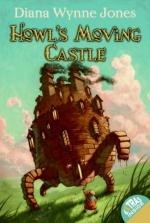|
This section contains 413 words (approx. 2 pages at 400 words per page) |

|
Howl's Moving Castle Summary & Study Guide Description
Howl's Moving Castle Summary & Study Guide includes comprehensive information and analysis to help you understand the book. This study guide contains the following sections:
This detailed literature summary also contains Related Titles on Howl's Moving Castle by Diana Wynne Jones.
Howl's Moving Castle is, on the surface at least, a fast-paced romantic romp through a familiar fairy tale landscape populated by witches and warlocks, shapeshifting characters, fire demons, and magic castles. All of these conventional elements are highly entertaining in themselves, as one may expect; however, they are also critical components of the intricate, humorous plotting for which Jones is famous. It is a measure of Jones's great talent that they are furthermore essential components of her theme, for she employs these customary accouterments of fantasy in such a way as to make readers question their own preconceived notions about such serious topics as selfidentity and self-expectation, the personal and social relevance of age, and the many faces and meanings of love.
The author places this entire mixture into yet another familiar context, that of the battle between good and evil, which is expressed here as a struggle between forces which affirm life and the individual, and those which degrade or destroy life. Unlike many fantasies which portray this same battle (for instance, J. R. R. Tolkien's The Lord of the Rings [1954-1955] and C. S. Lewis's The Chronicles of Narnia [19501956]), here it is above all perceptual, rather than physical, in character, for it depends on the intricate play of truth and illusion, appearance and reality.
For example, although the reader is always sure Sophie Hatter is on the side of right and the Witch of the Waste is on the side of wrong, there frequently remains doubt as to which side Wizard Howl and his associates belong.
Jones does not perceive such important problems as the difference between reality and illusion or good and evil as pertinent only to the realm of fantasy: The magical door in Howl's castle opens onto not only the fairy landscape of Ingary, but that of modern Wales as well. That is why she places Howl's young nephew, Neil, who is as enthralled by outward appearances as his uncle, firmly within the contemporary Welsh landscape.
The parallel worlds encourage the reader to make connections between a world governed by magic and one governed by media; for both, Jones seems to say, have much in common, much that can harm the dignity (to judge from Neil) and authenticity (to judge from Howl) of the individual. Thus the novel is not only a fantasy romance, but also a cautionary tale, for it reminds the reader that images and appearances can be readily manipulated, with potentially disastrous results.
Read more from the Study Guide
|
This section contains 413 words (approx. 2 pages at 400 words per page) |

|



